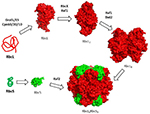Chaperone proteins involved in Rubisco biosynthesis
DOI:
https://doi.org/10.18388/pb.2021_397Abstract
Rubisco is an enzyme found in photosynthetic organisms, which catalyse the first step of biomass accumulation: the carbon dioxide incorporation to ribulose-1,5-bisphosphate. Because of Rubisco’s complicated, multimeric structure and a presence of many labile structural elements the enzyme cannot assemble to its native quaternary structure by itself. This is why the folding and assembly process of Rubisco requires the strictly organized operation of a number of auxiliary factors. Chaperone proteins take part in folding of holoenzyme subunits, subsequently they mediate in subunit oligomerisation, and in some cases chaperone proteins direct subunits to their cellular destination such as the carboxysomes or the pyrenoid. In addition to their canonical function of mediating Rubisco assembly, these chaperones are involved in additional processes such as quality control of the biosynthetic process, and regulation of organelle physiology and cellular compartments.

Published
Issue
Section
License
Copyright (c) 2021 Advances in Biochemistry

This work is licensed under a Creative Commons Attribution 4.0 International License.
All journal contents are distributed under the Creative Commons Attribution-ShareAlike 4.0 International (CC BY-SA 4.0) license. Everybody may use the content following terms: Attribution — You must give appropriate credit, provide a link to the license, and indicate if changes were made, ShareAlike — If you remix, transform, or build upon the material, you must distribute your contributions under the same license as the original. There are no additional restrictions — You may not apply legal terms or technological measures that legally restrict others from doing anything the license permits.
Copyright for all published papers © stays with the authors.
Copyright for the journal: © Polish Biochemical Society.



